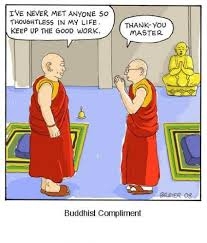Welcome home! Please contact lincoln@icrontic.com if you have any difficulty logging in or using the site. New registrations must be manually approved which may take several days. Can't log in? Try clearing your browser's cookies.
No thoughts or awareness of thoughts?
in Mindfulness
When I practice mindfulness, there is usually an awareness of thoughts rather than an emptiness or blank. Normally, I get identified with thoughts. But in a mindful state, there is no such identification. Yet the thoughts are there, lots of them. There is no empty state, totally free of thoughts.
This has been my experience so far. Others can share their insights.
3



Comments
Keep breathing and the thoughts will run out of steam.
Come to think of it, the same thing will happen if you stop breathing.
Its not about the suppression of thoughts, though I frequently have periods in meditation where there are no thoughts but seeing them as impermanent, suffering and not self. I've given up trying to get periods of not thinking as that is just the ego desiring and rather try to make my peace with whatever arises at the sense doors.
However @techie the non-identification with them is a good skill.
As @Lonely_Traveller said, it's not about suppressing your thoughts.
Acknowledge they are there, but don't engage in discursive sparring with them.
Just keep breathing and let them drift off.
Being aware of their presence rather than getting carried away is quite a feat already.
know that the thought comes from within
the person or thing in that thought is inside not outside
check whether it is wise thing to engage with a person or thing which is inside thinking s/he or it is outside
if we do engage with a 'thought'
how wise we could be?
how foolish we could be?
so
be patient, catch a thought, remind yourself 'thought is a thought but not a person or thing'
the next moment 'mind' is free
then there is another thought would come
do the same
then another moment of 'freedom'
do the same
you/we are doing Insight meditation
In general, I follow the standard practice of acknowledging but not attaching to, or recoiling from, thoughts and allowing them to pass as they will, and of actually counting the breath if thoughts become too boisterous.
Years ago, I made efforts to make them cease altogether, and my principal method was to visualize a power conduit in my mind through which energy flowed to the thoughts ( a natural visualization for me ). Then I would imagine flipping a switch - click! I could almost hear it - and thoughts would cease completely. The effect lasted for varying amounts of time and the thoughts would return, but usually somewhat diminished in strength. To this day, I am not certain if this was a useful technique or just a diversion.
Something else that I only recently stumbled on as a consequence of my attempts to deal with migraine pain - which in the ordinary course of events will continue for the entire day. I found a method where the headache can be stopped by sitting as in meditation and going to a particular dark and silent place in the core of the mind. I cannot at present put words to the procedure, but one thing I noticed about it was that words and thoughts are completely absent.
no words there is no thoughts
no words there is no pain
no words there is no thinking
no words there is nothing, no thing
Very interesting techniques @Fosdick - I would suggest it is 'right concentration'. Diversion? mmm ... the ability to overcome migraines is awesome.
http://www.webmd.com/pain-management/hypnosis-meditation-and-relaxation-for-pain-treatment
@upekka said
OK, I'll bite - is that a quote, and if so where does is come from? It's a perfect fit, and I'm always on the lookout for things to make what I'm going to do anyway sound more like real Buddhism.
from within
@upekka has become the dharma [lobster faints] What a team! What a sangha!
Keep grounded upekka, don't want you floating away to La-La Buddha Purelands ...
As others have said, non-suppresion as well as non-identification of thoughts is key and while I agree there is no state where there is no thought, there are frames of mind where thought is mechanical and not analytical.
Also there is the practice of expanding the space between thoughts which I often use to get prepped for zazen. Not to help focus on no thoughts but to help me find my breath easier if that makes any sense at all.
Hm well, I usually only notice my thoughts quite late, at the point of action. So while I meditate my mind appears empty, but as soon as I stop and focus on something it is as if dimly visible background thoughts come into perspective. Which makes me think my thoughts are only hiding somewhere in the mists of my mind, rather than are properly stilled.
@Kerome i always think of the mind as a conveyor belt. Sometimes it moves too fast, sometimes not much at all. Sometimes it appears stopped, but all the items are still on the belt the same way thoughts are still waiting to be generated by my mind. It's what the mind does. We just learn how to control the conveyor a bit better.
Thoughts will always be there. Just know that they're there. Thoughts themselves shouldn't be a factor because they are necessary as much as a heartbeat is.
How we react to them and how they affect us is where we should pay attention. Just noticing thoughts "in and of themselves" is how not to identify with them. The end result will be a calm attention or meditative state.
Thoughts are a bit of a nuisance really.
i've found that counting the breath is useful in allowing thoughts to just be thoughts.
they come, they go; there is no identification other than calling them 'thoughts' and letting them run their course.
once i notice that i'm thinking, i bring my attention back to the counting of my breath.
when walking, count the steps
when counting
instead of one, two, three etc. try and see wa n, t u, th r i, etc.
happy counting!
That is my experience but not its knowing. In other words the knower is a blank/emptiness but the known is a form of thought ...
Or possibly the sum of potentialities of thought...
You're right...They have a nasty habit of charming the mind, (that is, the mind becomes charmed by its own thoughts) and when this happens, if you're not careful, you can end up in all kinds of strife ...When thoughts come knocking...pay them no mind
...When thoughts come knocking...pay them no mind 

But there can be thought-free knowing.
Just an update.
Still the same situation, I am the observer and thoughts are being observed. There's a gap.
Will this just go on, or is there a destination here? Will this lead to some other state, like the void?
I don't see how non identification could be an end in itself.
When I meditate, I'm able to take a vacation from thoughts. It's very restful. I was told by a Tibetan monk that that was not proper meditation, but others have said that that is what "calm abiding" is about.
Pah!
Start with improper meditation, pretend meditation, pieces of peace, alarm abiding, whatever ...
Until you can tell Tibetan monks what is proper and what is just property ...
I think you're over-thinking this.
Seriously.
OP, if the thoughts are there, just observe them arising and falling. Practice not getting attached/involved with them, and just letting them fade away. If another thought comes up, just let it go. Stick with this practice.
Don't expect magic to happen, just patiently sit, and let the thoughts arise, then fade. Over time, weeks, months, you'll notice there may be fewer thoughts. The mind will start to grow stiller, not quite as actively generating thoughts. Stay with the practice. Don't rush it. Don't expect anything special. Don't tell yourself, "Well, I've been doing this since last summer, I should be at a new stage by now!" Just sit. Focus on the breath, if it helps: slowly innnnnn, slowly ouuutttttt. Slow, deep breaths.
Keep it up. No expectations, just quietude.
It's somewhat paradoxical. I find that the more clearly I can focus attention on thoughts, feelings, whatever, the less I have a sense of "me" observing. It's like there are just the thoughts, feelings, sensations, sights and sounds.
I think this passage from the Bahiya Sutta is relevant here:
"Then, Bāhiya, you should train yourself thus: In reference to the seen, there will be only the seen. In reference to the heard, only the heard. In reference to the sensed, only the sensed. In reference to the cognized, only the cognized. That is how you should train yourself. When for you there will be only the seen in reference to the seen, only the heard in reference to the heard, only the sensed in reference to the sensed, only the cognized in reference to the cognized, then, Bāhiya, there is no you in connection with that. When there is no you in connection with that, there is no you there. When there is no you there, you are neither here nor yonder nor between the two. This, just this, is the end of stress."[2]
http://www.accesstoinsight.org/tipitaka/kn/ud/ud.1.10.than.html
.
where does thought come from?
which is the medium to know the said thought?
where does feeling come from?
which is the medium to know the said feeling?
where does sensation come from?
which is the medium to know the said sensation?
where does sight come from?
which is the medium to know the said sight?
where does sound come from?
which is the medium to know the said sound?
how long said thought, feeling, sensation, sight, and sound stay?
where does it go?
is there anything apart from seeing sight, hearing sound, etc. in the world?
The world or our world?
what is the difference?
@techie my feeling is @Dakini has provided the best advice about the gentle slowing/emptying of the constant mind chatter.
It can be very subtle when we are trying 'real hard' to get to a more restful/peaceful/emptied state. Being gentle with a rogue mind is an acquired ability that takes time. It is a bit like wanting to develop patience - right now ... The desire for immediacy has to be relaxed ...
Maybe, but I am a little frustrated that things remain the same. No experience, nothing novel or earth-shattering. It makes me question progress.
I know about this, but sorry ... whether you acknowledge the 'thinker' or not, thoughts are still there. That's the problem. You may see only thought/object (and not the thinker/subject), that doesn't bring about any fundamental change. Things go on, as always. The chattering goes on, the disturbance goes on. So this sutra sounds philosophically good but practically ...? Again, no offense. Just thinking it out loud.
Yeah. Maybe it was because in their tradition, there are a lot of meditations that are visualization exercises of various sorts. Maybe they don't do complete calm and blank mind meditation.